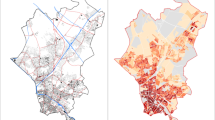Abstract
Streets can be made more liveable by ensuring that they are accessible to everyone. This requires the identification of ways to overcome the barriers to access for those who are socially excluded. In order to address these issues, a software tool, AMELIA (A Methodology for Enhancing Life by Increasing Accessibility), is being developed to test the extent to which transport policies can increase social inclusion. This is part of a research project being carried out as part of a large programme looking at ‘Accessibility and User Needs in Transport in a Sustainable Urban Environment’. AMELIA will be used to investigate how many more people are able to reach various opportunities, including shops, medical and welfare centres, employment and leisure facilities. It will be used to establish how many people meet accessibility benchmarks defined elsewhere in the project with and without the policy intervention. Micro-level data based upon street audits have been collected for the city of St Albans in Hertfordshire, including details such as steps, slopes, access to individual buildings, and obstructions on the pavement. In this paper, the effect of removing barriers to movement on the street is discussed because, by doing so, streets can be made more liveable.

Similar content being viewed by others
References
Axelson, P.W., Wong, K.M. and Kirschbaum, J.B. (1999) Development of an assessment process to evaluate sidewalk accessibility, Transportation Research Record, 1671: 5–10.
Banister, D. and Bowling, A. (2004) Quality of life for the elderly: the transport dimension, Transport Policy, 11: 105–115.
Church, R.L. and Marston, J.R. (2003) Measuring accessibility for people with a disability, Geographical Analysis, 35 (1): 83–96.
Department for Transport. (2005a) Inclusive mobility, originally published 2002, updated 2005, available from http://www.dft.gov.uk/transportforyou/access/tipws/inclusivemobility (accessed 5 June 2008).
Department for Transport. (2005b) Guidance on Accessibility Planning in Local Transport Plans. London: DfT, available from http://www.dft.gov.uk/transportforyou/access/peti/inclusivemobility (accessed 5 June 2008).
Gilhooly, M., Hamilton, K., O'Neill, M., Gow, J., Webster, N. and Pike, F. (2002) Transport and ageing: extending quality of life via public and private transport. Economic and Social Research Council Growing Older Programme, Findings 6, University of Sheffield.
Handy, S.L. and Clifton, K.J. (2001) Evaluating neighbourhood accessibility: possibilities and practicalities, Journal of Transportation and Statistics, 4 (2/3): 67–78.
Handy, S. and Niemeier, D. (1997) Measuring accessibility: an exploration of issues and alternatives, Environment and Planning A, 29 (7): 1175–1194.
Hertfordshire County Council. (2006) Hertfordshire's local transport plan, 2006/07–2010/11, available from http://www.hertsdirect.org/envroads/roadstrans/transplan/ltp/ (accessed 5 June 2008).
Jones, P., Titheridge, H., Wixey, S. and Christodoulou, G. (2006) ‘WALC’: Measuring pedestrian access to local bus and rail stations, talking into account traveller perceptions. 11th International Conference on Travel Behaviour Research, Kyoto, 16–20, August 2006.
Jones, P. and Wixey, S. (2005) Measuring accessibility as experienced by different socially disadvantaged groups. SAMP end of project summary report, University of Westminster, available from http://home.wmin.ac.uk/transport/download/SAMP_WP8_Final_Summary_Report.pdf (accessed 5 June 2008).
Mackett, R.L., Achuthan, K. and Titheridge, H. (2007) Conflicts between macro level policy and micro level implementation – the case of social exclusion, Proceedings of the World Conference on Transport Research, Berkeley, California, June, 2007, available from http://www.aunt-sue.info/publications.html (accessed 5 June 2008).
Mackett, R.L., Paskins, J. and Titheridge, H. (2004) The incorporation of social inclusion into policies in local transport plans (LTPs) AUNT-SUE Scoping Study Report, available from http://www.aunt-sue.info/publications.html (accessed 5 June 2008).
Matthews, H., Beale, L., Picton, P. and Briggs, D. (2003) Modelling access with GIS in urban systems (MAGUS): capturing the experiences of wheelchair users, Area, 35 (1): 34–45.
Metz, D.H. (2000) Mobility of older people and their quality of life, Transport Policy, 7: 140–152.
Oppenheim, C. (1998) An Inclusive Society: Strategies for Tackling Poverty. London: Institute for Public. Policy Research.
Ordnance Survey. (2006) Ordnance survey points of interest classification scheme, available from http://www.ordnancesurvey.co.uk/oswebsite/products/pointsofinterest/techinfo.html (accessed 5 June 2008).
Reneland, M. (2005) Accessibility calculations in six Swedish towns, in Kungolos, A.G., Brebbia, C.A. and Beriatos, E. (eds.) Sustainable Development and Planning II. Southampton: WIT Press, Vol. 2, pp. 903–912.
Smith, N., Beckhelling, J., Ivaldi, A., Kellard, K., Sandu, A. and Tarrant, C. (2006) Evidence base review on mobility: choices and barriers for different social groups. Report to the Department for Transport, available from http://www.dft.gov.uk/pgr/scienceresearch/social/evidence_base_review_on_mobility (accessed 5 June 2008).
Sobek, A.D. and Miller, H.J. (2006) U-Access: a web-based system for routing pedestrians of differing abilities, Journal of Geographical Systems, 8: 269–287.
Solomon, J. and Titheridge, H. (2006) Accessibility indicators and the policy goal of the reduction of transport-related social exclusion. CTS Working Paper, No. 2006/3. Centre for Transport Studies, UCL, London.
Titheridge, H. and Solomon, J. (2007) Benchmarking accessibility for elderly persons. Proceedings of the 11th International Conference on Mobility and Transport for Elderly and Disabled Persons, Montreal, Canada, June 18–21.
Acknowledgements
This paper has been written as part of a project entitled ‘Accessibility and User Needs in Transport’, which is being funded by the UK Engineering and Physical Sciences Research Council (EPSRC) under Grant GR/S90867/01 as part of its Sustainable Urban Environments Programme. The cooperation of the Environment Department of Hertfordshire County Council is greatly appreciated.
Author information
Authors and Affiliations
Corresponding author
Rights and permissions
About this article
Cite this article
Mackett, R., Achuthan, K. & Titheridge, H. AMELIA: making streets more accessible for people with mobility difficulties. Urban Des Int 13, 81–89 (2008). https://doi.org/10.1057/udi.2008.12
Published:
Issue Date:
DOI: https://doi.org/10.1057/udi.2008.12




